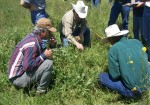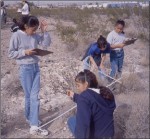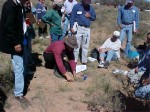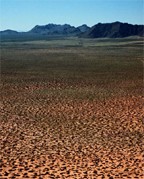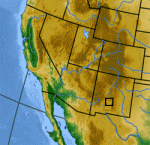The starkly simple elements of brilliant sunshine and desicated soils are deceiving. The Jornada del Muerto Basin in southern New Mexico is a complex ecological system --one in which extreme changes in vegetation and soils occur during human lifetimes.
Complexity is a liability for the scientists who must communicate the vagaries of this rugged but delicate system to the human residents who depend on it. Uncertainty can be a scientist's most formidable foe. Reducing scientific uncertainties about a system requires much basic research and monitoring. While difficult to communicate, this basic knowledge is integral to identifying and predicting consequences of human uses.
Investigators at the Jornada Basin LTER site have demonstrated four successful approaches that illustrate how environmental indicators and conceptual models based on basic research in the region are being used to increase appreciation of ecological complexity, reduce environmental conflicts, and improve rangeland management:
- Conducting workshops to train ranchers, environmentalists and government agency personnel in the U.S. and Mexico, to use monitoring and assessment tools
- Developing ecological state and transition models
- Implementating integrated soil and vegetation management and monitoring plans
- Introducing schoolchildren to ecological and experimental design concepts
All of these approaches are grounded in science—using indicator data of basic ecosystem functions collected by the people involved in the monitoring exercises. By providing tools and knowledge we help them understand and apply the concepts they learn, including ‘soil-vegetation feedbacks’ and ‘ecological thresholds.’ The common understanding they gain by participating in their own environment enhances their decision-making and helps them achieve diverse goals.
Jornada Basin scientists are helping land management agencies to integrate scientific data with the knowledge of public employees, local residents and ranchers to create conceptual state and transition models to explain how climate, and human management of fire, livestock, and invasive species can have diverse effects on vegetation dynamics. “This project originated with the community itself,” says Jeff Herrick, USDA ARS investigator and project manager.
“There was strong demand from wide variety of groups including land management agencies, ranchers and environmentalists,” Herrick says. “For us it was important to find out what is important to land managers, to identify the relevant research, and to develop applied research projects to increase the relevance of the ongoing basic research to the managers and other interested groups and individuals.”
Over the past eight years, the project has expanded into a large collaborative effort, well supported by a wide range of groups, including (but by no means limited to) individuals working for the NRCS, BLM, Nature Conservancy, Conservation Fund, Quivira Coalition, USFS, NMSU, other ARS locations in Colorado, Idaho and Arizona, CIAT (Honduras), CATIE (Costa Rica) and INIFAP (Mexico), New Mexico State University and other universities, New Mexico Cattlegrowers, USGS.
“Primary financial support is from the USDA ARS Jornada Experimental Range. We have also received funding from the Department of Defense and the Natural Resource Conservation Service and LTER support for the basic research on which this work is based has been invaluable” Herrick says.
The multidisciplinary project (ecology, soil science, statistics, etc.) is received with enthusiasm in Herrick’s office. “The benefits are extremely positive,” Herrick says. “The cost is difficult to calculate because so many individuals and organizations have contributed to it. Because it’s spread so thinly across so many agencies, I have no clue how to even begin to calculate the cost given the fact that all of the work is collaborative and much of the work was developed to support multiple objectives.”
So far the project has produced a two volume quantitative monitoring manual (available late 2002 or early 2003), which integrates standard soil and vegetation methods with several new monitoring tools. The Jornada was also one of four organizations that produced a qualitative assessment manual. Workshops based on both of these manuals have been held throughout the US and northern Mexico, and the monitoring tools are now being tested and applied in Central America.
Participants in this project include: Jeffrey Herrick, Brandon Bestelmeyer, Kris Havstad (USDA-ARS), Patrick McCarthy (The Nature Conservancy), Stephanie Bestelmeyer (Chihuahuan Desert Nature Park), Alicia Melgoza INIFAP, Chihuahua Mexico, and Arlene Tugel (USDA-NRCS Soil Quality Institute), as well as well as many others

 Enlarge this image
Enlarge this image